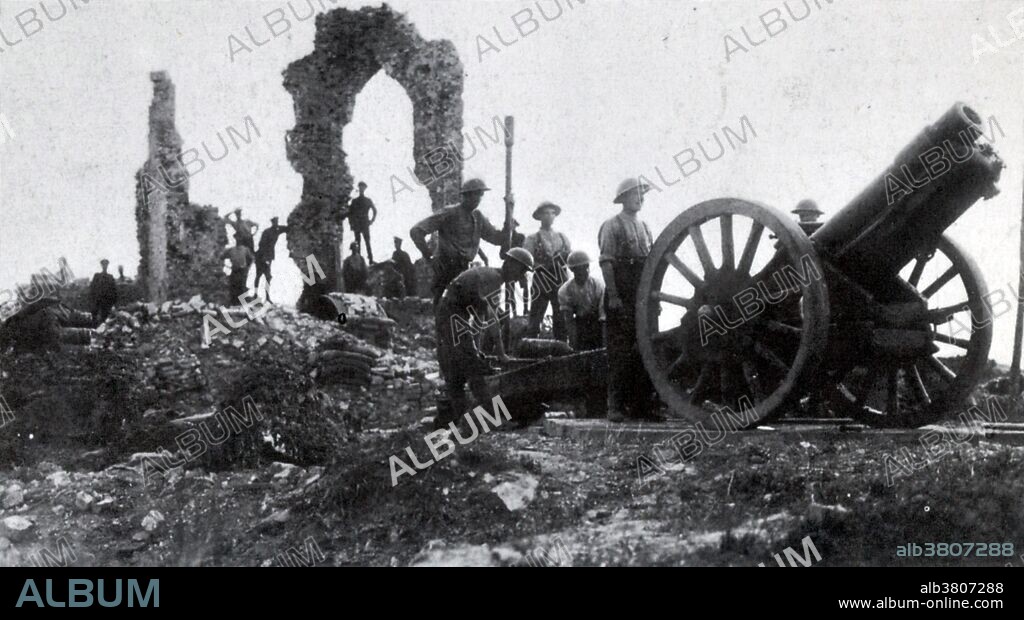alb3807288
WWI, BEF Howitzer Crew, Battle of Pilckem Ridge, 1917

|
Add to another lightbox |
|
Add to another lightbox |



Buy this image.
Select the use:

Title:
WWI, BEF Howitzer Crew, Battle of Pilckem Ridge, 1917
Caption:
British 6 inch howitzer crew, August 1917. The Ordnance BL 6 inch 26cwt howitzer was originally towed by horses but from 1916 onwards was commonly towed by a 4 wheel drive 3 ton lorry as heavy field artillery. The wooden spoked wheels could be fitted with "girdles" for work in mud or sand to prevent them sinking. The Battle of Pilckem Ridge, July 31 - August 2, 1917, was the opening attack of the main part of the Battle of Passchendaele. A substantial amount of ground was captured and a large number of casualties inflicted on the German defenders, but the German defenders also recaptured some ground on the XIX Corps front. Heavy rainfall had a serious effect on operations, causing more problems for the British who were advancing into the area devastated by artillery fire and was mostly flooded and muddy. The resistance of the German Fourth Army, unusually wet weather, the onset of winter and the diversion of British and French resources to Italy, allowed the Germans to avoid a general withdrawal. The campaign ended in November when the Canadian Corps captured Passchendaele.
Credit:
Album / Science Source / New York Public Library
Releases:
Model: No - Property: No
Rights questions?
Rights questions?
Image size:
4200 x 2326 px | 27.9 MB
Print size:
35.6 x 19.7 cm | 14.0 x 7.8 in (300 dpi)
Keywords:
1917 • 1ST WORLD WAR • 20 20TH XX XXTH TWENTIETH CENTURY • 20 XX TWENTIETH CENTURY • 20TH CENTURY • 20TH • ALLIED FORCES • AMMO • AMMUNITION • ARMED FORCES • ARMES • ARMIES ARMY • ARMIES • ARMS • ARMY • ARTILLERIST • ARTILLERY • ARTILLERY: HOWITZER • ARTILLERYMAN • ARTILLERYMEN • BATTLE OF PASSCHENDAELE • BATTLE OF PILCKEM RIDGE • BATTLE • BATTLEFIELD • BEF • BELGIAN • BELGIUM • BRITISH EXPEDITIONARY FORCE • BRITISH • BW • CELEBRITIES • CELEBRITY • COMBAT • ENGLISH • EVENT • EVENTS • FAMOUS PEOPLE • FAMOUS • FIELD ARTILLERY • FIELD GUN • FIRST AID • FIRST WORLD WAR • FIRST-AID • GLOBAL WAR • GREAT WAR • GUERRA • GUNNER • GUNNERY CREW • HEAVY FIELD ARTILLERY • HISTORIC • HISTORICAL • HISTORY • HOWITZER (CANON) • HOWITZER • HUNDRED YEARS WAR • I WORLD WAR • IMPORTANT • INJURED • MALE • MAN • MEN • MILITARY • MUNITION • MUNITIONS • NOTABLE • ORDNANCE BL 6 INCH 26CWT HOWITZER • PASSCHENDAELE • PHOTO • PHOTOGRAPH • STRETCHER PARTY • STRETCHER • THIRD BATTLE OF YPRES • TROOPS • TWENTIETH CENTURY • WAR • WARFARE • WARS • WEAPON • WEAPONARY • WEAPONRY • WEAPONS • WELL-KNOWN • WEST FLANDERS • WESTERN FRONT • WORLD WAR 1 • WORLD WAR I (1914-18) • WORLD WAR I • WORLD WAR ONE • WOUNDED • WW1 • WWI • YPRES SALIENT • YPRES
 Pinterest
Pinterest Twitter
Twitter Facebook
Facebook Copy link
Copy link Email
Email
